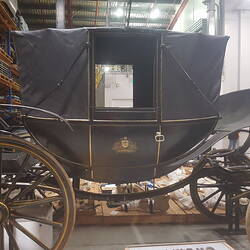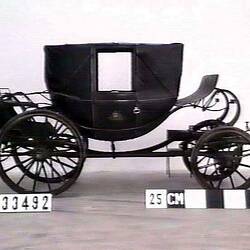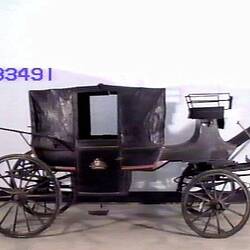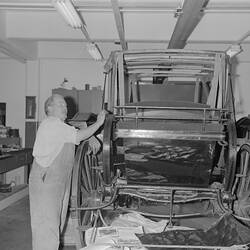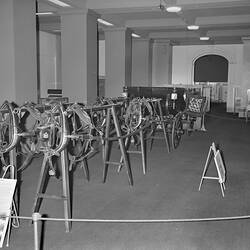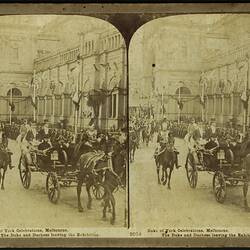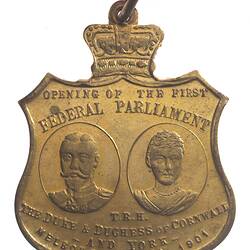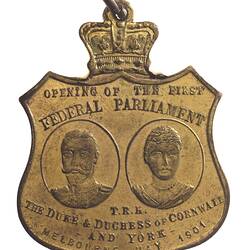Summary
State landau coach made by Hooper & Co, London, about 1897. The vehicle, which had room for four passengers, was drawn by four horses, with postilion riders on the left-hand horses. The landau was used in official ceremonial processions including the opening of the first Federal Parliament in Melbourne on 9th May 1901, the visit of the Duke and Duchess of York in 1927, and the visit of the Duke of Gloucester in October 1934 for Victoria's Centenary celebrations.
The landau was built in London and imported by Australia's first Governor-General, Lord Hopetoun. Melbourne's coach builders expressed their disappointment that an imported coach was used on such an important occasion.
In 1901, the undercarriage was painted vermilion and the body panels dark brown. The interior was a rich royal blue trimmed in blue Morocco leather, with the seal of Australia on each door. The current exterior paint scheme is black, with yellow and brown lining, and the Australian coat of arms is detailed on each door. The harness bears the Coat of Arms of Lord Denham, Governor-General of Australia from 1911-14.
Physical Description
State landau coach fitted with four hard rubber tyres, C-spring suspension and folding square leather hood. It also has a distinctive curved leather splasher or dashboard at the front and a rumble seat for a brakeman and footmen at the rear.
Significance
The State Landau is of national significance to the cultural and political history of Australia, being one of the few surviving large artefacts with a tangible association to the celebrations surrounding the opening of Australia's first Federal Parliament in Melbourne, in May 1901, and with Royal visits both on this and two subsequent occasions.
In the pre television and cinema age, street processions formed an important part of most public celebrations and were events of both spectacle and colour, typically including triumphal arches, bunting, banners and flags, as well as floats, horse-drawn carriages and riders in the finest livery.
It was in large mass public gatherings, such as the street parades before the opening of Federal Parliament at the Royal Exhibition Buildings, that most Australians at this time would have gained there only opportunity of seeing royalty. Street Processions with open horse-drawn carriages created an extraordinary sense of intimacy in which thousands of Victorians would feel they could almost touch their future Monarch or cry out and be heard be the ears of Royalty. For two generations of Australians in the early 20th century, the Governor's Landau and other similar State coaches created an image that was indelibly linked to their first experience and memories of Royalty.
Built by Hooper & Company, of London, in the late 1890s, the State Landau is a superb example of the coachbuilders' craft designed to the highest standard of comfort for Governors, official State visitors and Royalty. It is now a rare surviving example of the best standard of horse-drawn carriage used in Victoria with superior features such as double-sprung suspension, patent Collins axles and solid rubber tyres all designed for comfort and smooth riding. Despite having being repainted during the early 20th century, the Landau is remarkably original for a horse-drawn vehicle of its age, retaining features such as original upholstery, patent leather dash and mudguards, which are often replaced in other vehicles in preservation. The high C-springs, rear rumble seat for footman and brakeman and the design for control by postilion riders mounted on the horses, rather than drivers seated on the carriage, are all signs of a vehicle designed for aristocratic use.
The same makers were subsequently to produce a similar carriage as the State Landau for King Edward VII in 1902, described as "the most magnificent example of the coachbuilders' craft in comparatively recent times".[1]
Statement prepared by Matthew Churchward, Senior Curator, Engineering & Transport
1. The Royal Mews, Buckingham Palace, Pitkin Pictorials Ltd, c.1970.
More Information
-
Collecting Areas
-
Acquisition Information
Loan & Subsequent Transfer from Library Council of Victoria, Aug 1973
-
Manufacturer
-
Place & Date of Event
Royal Exhibition Building (REB), Melbourne, Victoria, Australia, 9 May 1901
-
Person Named
HRH George F. Duke of Cornwall & York, Melbourne, Victoria, Australia, May 1901
-
Person Named
HRH Mary Duchess of Cornwall & York, Melbourne, Victoria, Australia, May 1901
-
Person Named
HRH Albert F. Duke of York, Melbourne, Victoria, Australia, Apr 1927
-
Person Named
HRH Henry Duke of Gloucester, Melbourne, Victoria, Australia, Oct 1934 - Nov 1934
-
Classification
-
Category
-
Discipline
-
Type of item
-
Overall Dimensions
4260 mm (Length), 1900 mm (Width), 2230 mm (Height)
Overall dimensions of vehicle with hood up. Note: Width was previously recorded as 1860 mm.
-
Overall Dimensions
4290 mm (Length), 1910 mm (Width), 1660 mm (Height)
Overall dimensions with hood lowered. Height measurement is to top of dash only. Dimensions measured by Conservation staff, note some details differ from above dimensions.
-
Other Dimensions
2600 mm (Length), 1650 mm (Width)
Wheelbase x Track Dimensions. Width of track is 1650 mm at rear wheels & 1550 m at front wheels. Note the wheels are set at a camber being wider at the top than the bottom where thet contact the road surface. At the top of the rear wheels the tyres 1700 mm apart over the axle.
-
Keywords
Australian Federation, 1901, Coaches, Horsedrawn Vehicles, Royal Visits, Melbourne Centenary, 1935, Victoria Centenary, 1934-1935

